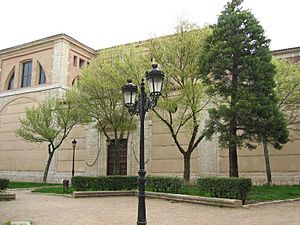Monastery of Santa María la Real de las Huelgas, Valladolid facts for kids
The Monastery of Santa María la Real de las Huelgas is a very old and important monastery in Spain. It was built for Cistercian nuns, who are a type of nun (religious woman) who follow the rules of the Cistercian Order. You can find it in the city of Valladolid, which is in the Duero region. The word Real in its name means "Royal," suggesting it was founded by someone from the royal family.
Contents
A Look at the Monastery's Past
Early Days and a Big Fire
The very first years of the monastery are a bit of a mystery. This is because a terrible fire in 1282 completely destroyed the building. All its old records and documents were lost in the flames.
Queen María de Molina's Help
After the fire, María de Molina (who was Queen of Castile and León from 1282 to 1295) helped the nuns. She gave them a palace that was used as a resting place. This is why the monastery got the name "of the Fallows" (las Huelgas), meaning a place of rest or unused land. The nuns moved into this new home. Today, only one gateway from that original palace remains. It's a special example of Mudéjar art in Valladolid, which is a style of art and architecture from Spain that mixes Christian and Islamic influences.
Who Started the Monastery?
One historian later suggested that the monastery was first started by Doña Sancha. She was the sister of Alfonso VII, who was the Emperor of Spain from 1135 to 1157. This idea makes sense because King Alfonso was a very religious man. He was the one who first brought the Cistercians (the religious order the nuns belong to) to Spain. He also founded the Knights of Calatrava, a military group that was part of the Cistercian Order.
Challenges and Growth
The monastery was located in a new area that had recently been taken back from Muslim rule during the Reconquista. This was a long period when Christian kingdoms in Spain fought to regain control of the Iberian Peninsula. The area around the monastery became peaceful enough for King Alfonso to trust his sister with it.
However, the monastery faced trouble again in 1328. King Alfonso XI, sometimes called "The Avenger," attacked it. He was trying to capture his grandmother, Queen María de Molina, who had retired there after he became king.
Peaceful Times and New Buildings
After these difficult times, the region became more peaceful. The nuns settled into their daily life of prayer and work. Over many years, they received gifts of land and farms nearby. This made them very important landowners in the area, with many special rights.
In 1482, under the leadership of Abbess Isabel de Herrera y de Guzmán, the nuns joined a reformed group called the Congregation of Castile. This meant they renewed their strong commitment to the Rule of St. Benedict, which is a set of rules for monastic life. This led to a period of great growth and success for the monastery, lasting until the mid-1600s.
Work on the monastery's church began in 1579 when Ana Quijada y de Mendoza was the Abbess. The church was finished in 1599. The cloister, which is an open area surrounded by covered walkways, was completely rebuilt in 1622. A count of the monastery in 1665 showed there were 42 nuns living there. They also had 20 servants and two monks who served as their chaplains (priests who lead religious services). These chaplains had a housekeeper and two servants of their own.
Surviving Wars and Changes
The monastery faced more challenges during the Spanish War of Independence in the 1800s. At this time, the government took away many of their lands. However, the monastery managed to survive and recover after this period in Spain's history.
Because they lost their land and income, the nuns opened a boarding school in 1895. They also survived the Spanish Civil War (1936-1939) under the leadership of Abbess Purificación Martín. After that war, the community built a new school building, which was completed in 1966.
In 1931, the monastery was recognized as a National Monument, meaning it's an important historical site.
The Monastery Today
As of 2011, the monastery had 17 nuns. Their Abbess, María del Mar Martínez Lopez, was elected in 2002. With help from the local government, they built a modern cloister, which opened in 2007.
The nuns also have a smaller "daughter house" called the Monastery of Alconada. It is located in the Province of Palencia and has four nuns. The Monastery of Santa María la Real de las Huelgas remains part of the Congregation of St. Bernard of Castile, which is part of the worldwide Cistercian Order.
Important Burials
See also
 In Spanish: Monasterio de las Huelgas Reales (Valladolid) para niños
In Spanish: Monasterio de las Huelgas Reales (Valladolid) para niños


